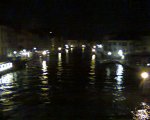Wild Venice



By markle
- 4175 reads
Wild Venice
Peter Ackroyd subtitles his book on Venice “Pure City” – which to an English imagination initially seems very strange. Surely Venice is the place of Iago and the moral vacuum of Shylock’s persecutors, of homicidal dwarves in dark alleys, of an economy based on tourist tat? But what Ackroyd means is that it is purely city – it never had a rural prehistory, unlike London or New York: humanity has built it almost from the sea itself; it has only every existed as a city and the urban is its only ecosystem.
It’s a powerful conceit. As a way of understanding Venice’s history and distinctiveness it’s very effective. But it’s not quite true. Even if its waters are often polluted and stagnant, it is still a part of the lagoon in which it sits.
The city’s wildlife creeps up its waterways. Some clings green to the embankments or drifts just below the surface in weedy chains, especially where the Grand Canal opens to the wider water. Fish feed on these algal clusters – at least, the birds suggest so.
At the foot of Santa Maria della Salute, cormorants fish between the vaporettos and smaller boats. We were there on a bright February day, sun seeming to touch each stone individually. We 3atched the birds’ black streaks dive and rise, their movements setting off reactions of colour across the surface of the water.
Further into the city, we encountered an egret at the foot of the Accademia Bridge. At first, we saw it from above, as we leant on the wooden beams to look up and down the Canal. An egret from above is a paint thumbprint on the background.
But from ground level it has something of the heron, that sense of always stalking, even while at rest. Its scaly feet gripped the top of a beam protecting the pontoon of the vaporetto stop. Its beak scratched through in a preen that seemed to scarify feathers and flesh.
All the best cities (I think) are walking cities, where foot to floor seems to feed the eye’s ability to catch detail, where taking an unexpected turn brings new things, not hours of slogging between banks and takeaways. For all its water, Venice is a walking place.
As we went along the narrow streets, up and down the thousands of steps, we passed through a sequence of geometric forms – the rectangle of the passageway, the curve of a dome, the squares of the paving slabs under foot. Carvings are set into walls, their edges clearly delineated against the surrounding shapes. If Venice sometimes feels like it is slightly slumped over, its buildings not quite steady, it is also a place of sharp lines and contours, especially in the February sun.
But where the sky appears between the roofs, it moves with pigeons, whose flocks billow and bend. Where the stone feels as though it’s in two dimensions, the spread of grey bodies bulks, retreats, seems to balloon and then shrink into the distance. Individual birds dissolve into the silvered movement. Even on the ground, dotted among tourists, they present a shifting, complex balance to the walls and doorways.
One evening I walked from San Marco to the railway station, and back again on the other side of the Grand Canal. Each bridge I crossed showed me water flecking with reflections. To stop, but stay with movement through my eyes, gave each bridge the feel of something on its way to life. (I know that Venice makes visitors prey to fantasies.)
Walking led us to one of the city’s edges. We went east, along the banks of the Grand Canal, sometimes drifting inland, past the brickwork of the Arsenale and the muddy park at the gates of the Biennale pavilions. It’s a gentle stroll in the cool of a sunny February, with trees and playgrounds, and the water to the right hazed with vapour out to the other islands.
We stopped on the tailfin of the fish (Venice from the air looks like a huge fish in the lagoon) where the city ended and water stretched into ambiguous colours of distance. Another wood-beam bridge crossed a concrete-lines canal into some sort of military school. We relaxed on the steps, enjoying the quiet and calm. Then I looked left and saw the mountains.
On the day we went up in the lift of the Campanile in the Piazza San Marco, cloud kept out the view to the city itself, its thousands of roofs and spires, like an intricate game for which we needed some dice. At the time it seemed right that, in the heart of Venice, all we could see was Venice.
But here, out in Sant’Elena, we could see the Dolomites. The snow showed white against a background of stone that appeared deep blue, just a few shades darker than the sky. To be in Venice and to see mountains – how perverse, and how brilliant.
Another egret was brooding over the water below us. It sat among the boats moored as cars would be strung along a suburban road. We watched its stillness for a while, until a whirr blazed along the water.
“Kingfisher!” I shouted.
It went below our feet, a straight-line fizz of colour. Its brightness disappeared into the light reflected from the lagoon. We turned back towards the city again, feeling far more exhilarated than we already had. Every place is changed when you see a kingfisher there.
As if to round off our wildlife-dotted trip, while we waited for our flight at Marco Polo Airport, we watched a rabbit munch on grass outside the check-in hall. We were gradually joined by other families until quite a crowd was staring at, and photographing, the oblivious animal.
Other forms of life were always around us in the “pure city”; they’re there in all other cities too, even though it’s easy for people never to see them.
- Log in to post comments
Comments
a really enjoyable piece of
a really enjoyable piece of travel writing. Makes me want to go there!
one small typo:
We 3atched the birds’ black streaks dive and rise, their movements setting off reactions of colour across the surface of the water.
- Log in to post comments
How lovely! I like this
How lovely! I like this focus on the natural world in the wonderful human construction that is Venice.
- Log in to post comments
This is stunning. The
This is stunning. The geographical location pinned down so well, the links with literature, it's like being taken on a visual, rich journey. That's why it's our Facebook and Twitter Pick of the Day and also our Story of the Week.
- Log in to post comments
another fine piece. the
another fine piece. the visual details bring it all to life.
- Log in to post comments
I've worked and studied in
I've worked and studied in Italy, but had never been to Venice. Now I feel I have! Great and inspiring piece,
Linda
- Log in to post comments


